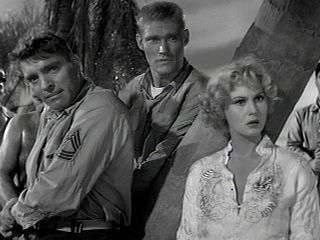南海ピンク作戦 ★☆☆
(South Sea Woman)
1953 US
監督:アーサー・ルービン
出演:バート・ランカスター、バージニア・メイヨ、チャック・コナーズ、ポール・バーク
左:バート・ランカスター、中:チャック・コナーズ、右:バージニア・メイヨ
映画には、いわゆる1つの「ジャンル」なるものが存在することは、誰でもご承知のことでしょう。西部劇、戦争、コメディ、ロマンス、歴史劇、アクション、ドラマ、スリラー、ホラー、SF、ミュージカルなどのメインジャンルから、たとえばコメディであればロマンティックコメディ、スラップスティックコメディなどのサブジャンルまで数多くのジャンル分類が存在します。しかしながら、ある作品は必ずどれか1つのジャンルに分類されなければならないことはなく、ジャンルが混淆する作品も数多く見られます。たとえば、極端な例でいえば、全く正反対であるように見えるコメディとホラーですら混淆されることがあり、「ゴーストバスターズ」シリーズ、「バタリアン」シリーズなどがその良い例です。最近日本で公開されるアメリカ映画のほとんどはアクション映画である為、というよりも本来他のジャンルに分類されるべき作品であっても、アクション映画とほとんど区別がつかない作品ばかりが日本で公開されるようになった為、映画全体に画一化された印象が避けられず、10年ほど前ですらもう少しバラエティに富んだライナップが揃っていたような気がします。では、なぜ「ジャンル」が存在するのでしょうか?実をいえば、映画におけるジャンルを専門に解説する本すらいくつかあるほど、この問いにはあま多の議論の余地がありますが、いずれにせよ、ジャンルを明確にしておくことは、製作者側の視点から見ると顧客獲得及びリピータ定着化というマーケティング戦略上において重要な役割を果たすのです。たとえば西部劇というジャンルの下に一連の作品を製作すれば、西部劇と銘打たれたある作品を見て気に入ったオーディエンスが、将来西部劇と銘打たれた別の作品を見るであろう確率は高くなるはずです。また勿論、オーディエンスの側からしても、ジャンルが明確であれば、高いおゼゼを払って次に見に行く映画を何にするか決定する為の明確な目安になります。たとえば、硬派を自認する御仁は、ロマンスと銘打たれた甘っちょろい作品は敬遠するだろうし、小心者を自認する御仁は、満員の映画館でキャッと叫びながら座席から飛び上がったなどという孫子の代まで伝わる不名誉を被らないようにホラーと銘打たれたおっかない作品は避けようとするでしょう。ということは、ジャンルが混淆する作品とはどのような作品かというと、製作者側の戦略上の立場からすれば、一石二鳥、場合によっては一石三鳥以上の効果が狙われた作品であることになります。つまり、「ゴーストバスターズ」シリーズは、コメディファンとホラーファンの両者を動員しようとする意図があるということです。John
C. Lydenという人は、「Film As Religion」(New York University Press)の中で、かの「タイタニック」(1997)もロマンスメロドラマ(a
romantic tearjerker)とアクションパニック映画(an action/disaster movie)の混淆作品(hybridization)であり、前者によって女性オーディエンスを、後者によって男性オーディエンスを動員しようとする一石二鳥が狙われた作品であると述べています。確かに考えてみれば、50年代に公開された「タイタニック」(1953)や「SOSタイタニック」(1958)には一方のロマンスの要素はなく、キャメロン版「タイタニック」はその意味でも一味違っていたことになります。さて随分前置きが長くなりましたが、ジャンルについてなぜ長々と説明したかというと、ここに取り上げる「南海ピンク作戦」は、究極のジャンル混淆映画だからです。何しろ法廷もの映画の体裁から開始され、コメディ->アクションアドベンチャー->戦争->ロマンスと次から次へとジャンルの境界を越えていくのです。最近流行の言葉を用いれば、これ以上の「てんこ盛り」の作品は考えられないほどに、「てんこ盛り」なのです。正直いえば、「てんこ盛り」という語が巷ではどのような意味で使用されているのか定かでありませんが、ここにいう「てんこ盛り」とは、単なる量の問題ではなく様々な種類の素材が雑煮のように映画作品という1つの容器に押し込まれている様を言います。先程、ジャンルの混淆は、製作者側が繰り出す1つの戦略であると述べましたが、「南海ピンク作戦」のような一石二鳥どころか一石五鳥を狙った作品は、戦略が戦略ではなくなる可能性が大なのです。なぜならば、あまりにも様々な素材を「てんこ盛り」にし過ぎると、焦点が定まらないヌエのような作品に終わるのはむしろ当然であり、それこそ一石五鳥を狙って結局一羽もモノにできなかったという結果になるのが普通だからです。そもそも一石二鳥という言葉そのものが、「一石二鳥を狙って欲張った結果、どちらも取り逃がしてしまった」などと虻蜂取らずの結果に終ったネガティブなケースにも適用されるように思われ、「南海ピンク作戦」は、見事にそのような陥穽に陥っているように思われます。であるにも関わらず、わざわざここに取り上げた理由は、ここまで徹底的にジャンルが混淆された作品は他には見たことがなく、その意味で極めて貴重だからです。では、どれほど「てんこ盛り」であるか説明しましょう。「南海ピンク作戦」は、軍事法廷で海兵隊の軍曹?(バート・ランカスター)が敵前逃亡を含めた数々の不名誉な行状によって裁かれるシーンから開始されます。実は、「南海ピンク作戦」では、裁かれる当人を含め軍事法廷に出頭した様々な証人が過去を回想するフラッシュバックシーンが寄せ集められて1つのストーリーが構成され、最後は彼と彼の相棒(チャック・コナーズ)の名誉が回復されます。従って、作品全体が軍事法廷ものの枠組みに従って組み立てられていると考えられます。因みに、単に法廷ものということではなく軍事法廷もの映画ということになると、イギリス映画ではしばしば見掛けますが、アメリカ映画ではほとんど見掛けません。「ケイン号の叛乱」(1954)には確かに軍事法廷シーンがありますが、それも終盤のみです。「南海ピンク作戦」のフラッシュバックシーンは、実に多様であり、最初はコメディ調で始まります。何しろ、バート・ランカスター、チャック・コナーズ、バージニア・メイヨ演ずる三人の主人公達は、文字通り酒場を川に沈めてしまうのです。三人がガダルカナル島近くの南洋の島に到着すると、コメディ調を維持しながらも、次第に当時のバート・ランカスターが得意としていた劇画調アクションアドベンチャーの様相が濃くなり、銃撃戦すら展開されるようになります。三人が船に乗って再び島を離れると、何と!今度は太平洋戦争当時のドキュメンタリークリップを駆使したシリアスな戦争映画に変わります。このパートには、日本軍が登場し、主人公達は日本軍の駆逐艦及び上陸用舟艇とド派手な砲撃戦を展開します。そして最後は、チャック・コナーズ演ずる相棒が、日本軍の駆逐艦の煙突によじ登り爆弾を投げ込んで壮烈な最期を遂げます。ここに至って典型的なヒーロー物語に早変わりするのです。また、バート・ランカスター、チャック・コナーズ、バージニア・メイヨという組み合わせから容易に想像されるように、「南海ピンク作戦」にはロマンスの要素もあり、確かに主演のバート・ランカスターとバージニア・メイヨは最後の最後になるまで互いに反目しているように見えますが、ラストシーンで両者が目出度し目出度しになることによって、実は当作品がロマンスでもあったことが明確になります。このように、数々のジャンルが混淆され、個々のジャンルで常套化されたシーンが次から次へと出現する「南海ピンク作戦」を見ていると、映画におけるジャンルとは何なのかに思いを馳せざるを得なくなります。どんなジャンルにも定型的なパターンがあり(むしろ定型的なパターンが存在することをジャンルが成立する為の必要条件であると考える評論家もいます)、複数ジャンルに渡って一挙にそれを見せられると、一方では消化不良を起しそうになりつつも、どれも見たことがあるようなシーンばかりなので他方で妙な安心感があるのも確かです。要するに、各ジャンルの代表的作品のさわりの部分ばかりを集めた、いいとこどりのアンソロジーといった趣があり、その意味では確かにエンターテイニングであることに間違いはありません。実は、「南海ピンク作戦」のこのようなジャンル混淆的な性格については、Jeanine
Basingerが「The World War II Combat Film」(Wesleyan Unversity Press)の中で見事に解説しているので、脚注として以下にその部分の全文を挙げておきました。長いので根性がなくて訳しませんでしたが、興味深い指摘が含まれているので英語が問題でなければ是非読んで下さい。
※Jeanine Basingerによる当作品の解説を以下に記しておきます(「The World War II Combat Film」のP240-242)。尚、作品タイトルの斜字体は原文にあるものです。
The complexity of genre may be further illustrated by a 1953 film, South Sea Woman(「南海ピンク作戦」のことです:入間洋),starring Burt Lancaster, Chuck Connors, and Virginia
Mayo. Coming at the end of the Korean conflict, it reflects a new interest
in the characters and situations of war, for it contains at its base a
Quirt/Flagg relationship, that of the competitive camaraderie between Lancaster
and Connors. It is set in the context of a military court being held in
San Diego in 1942. Burt Lancaster is on trial for desertion, and the story
unfolds in "flashback" testimony from a series of characters
who witnessed various portions of the total events. The use of the flashback
is interesting, because the 1953 audience would already associate World
War II with the past. It represents a return to a time of more coherent
feelings, a more acceptable and clearcut war than Korea.
The film is a latter-day hybrid of the type described as popular during
the historical period in which it is set(1940-1942) such films as Somewhere I'll Find You, A Yank in the R.A.F., and They Met in Bombay, as described elsewhere. It takes a fundamental military service comedy
plot from the 1930s in which Lancaster and Connors (Quirt and Flagg) are
opposing forces. Lancaster is a True Marine, devoted to his duty, and Connors
runs away. Lancaster follows him to save him from his folly, and they embark
on a series of madcap adventures: they sink a saloon (yes, don't ask),
destroy a Chinese junk with firecrackers, and swim to shore on a tropical
island. Layered over this 1930 service plot is a World War II initiation-to-duty
plot, in which they learn on the island that the Japanese have bombed Pearl
Harbor, and the United States is at war with Japan and Germany. Because
the island is held by the Vichy French, they pretend to be deserters so
they can roam free. They spend their time in a hotel run by a French woman
(reminiscent of the French canteens of World War I) and end up releasing
all the Free French that are being held in dungeons on the island. This
portion of the film reflects the typical tongue-in-cheek, dashing adventure
story that Lancaster made popular at that time with Crimson Pirate, Flame and the Arrow, and Ten Tall Men. It is pure, fast-paced adventure.
Next, Lancaster - still trying to prevent Mayo from marrying Connors -
enlists the aid of a motley group of islanders (a drunk, an embezzler,
and a true deserter), in a miniature forerunner of the Dirty Dozen unholy group. Lancaster and these cohorts break up the wedding ceremony
of Mayo and Connors by dressing up in chicken suits! Now it appears we
are in the midst of a typical Bob Hope and Bing Crosby Road pictures. Yet just as we have settled in for commedy, they are chased
through the deep jungle, oursued by a German captain and his troops, and
shadowy lighting, tension, and real bullets place us in the depths of a
typical jungle warfare combat movie. As it turns out, the island is near
Guadalcanal!
As if this weren't enough, the heroes steal a yacht which is well stocked
with weapons and set out to do battle on the ocean. They bump into a group
of Japanese in a landing craft, under protection of a destroyer. While
underway there, they have found Virginia Mayo hidden on board and they
have also found time to rehabilitate the drunk they took with them. (There
is no development of the drunk's rehabilitation. The narration tells us
about it.) Our heroes open fire on the destroyer, and what happens? True
combat breaks out before the viewer's eyes. The crew is killed. The Japanese
are wiped out. The destroyer is sunk. The charcter played by Chuck Connors
- the one who has been antimilitary and who was trying to desert - climbs
aboard the Japanese ship and loses his life while dropping grenades down
her smokestack into the arsenal. This is serious combat, culminating in
death for a hero. All ends well, with Lancaster giving a speech that says
marines are crazy but we need that kind of craziness. He sweeps Virginia
Mayo into his arms, kisses her, says he'll marry her, and when she faints,
remarks, "Now all we need is a preacher...and a motel."
Why bother with a films like South Sea Woman? Because it seeks to disguise its genre by its title, and it is, in fact,
a significant mixture of established genres: adventure, comedy, the service
comedy of the 1930s, the South Sea films, the star vehicle (Hope/Crosby
Road pictures), the pirate movie, the prison escape picture, and the costume
drama. It is possible to say that South Sea Woman does not count, because it is a mixture of genres...or because it is not a recognizable genre...or even because it is a mess. However, that's a bit too easy. A film like South Sea Woman illustrates the point that the story patterns of genre and/or its central
issues can move from setting to setting, and that once the conventions
are established, they do not have to be used in a pure form. Films like
South Sea Woman keep generic traditions alive in times when they are not popular, but
they could not do so if the traditions were not established. They act as
tenders of the flames in times when certain patterns are not right for
what is in the minds of the viewers. They don't complete any one of their
genre stories, or fully develop them, but they use them as if they are
known.

